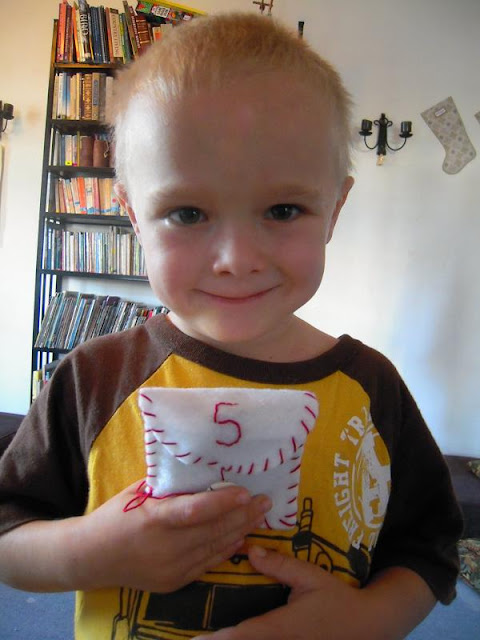We began our investigation of the History of the Old Testament this year with Creation. Our text is the Bible and the reader of that is Dad. I began these
notebooking pages a week or so after they had heard the story from Dad as a fun way to illustrate and narrate what God created on each day. We did a couple of pages a week adding copy work to them to record the story and give more practice to handwriting. The above selections of work were done by my oldest son Max.
Day One by T.J. He just had to add people and a house!
Day Two by Max.
Day Three by Zak.
Day Four by Max. "You will notice," says Max as he is drawing, "That the sun in real life really has no rays. So my sun is just a round blob."
Day Five by Zak. You will notice that one of the dolphins has some red on it...yes it is blood. Zak says that a shark from the waters below has taken a bite out of the dolphin and the dolphin is swimming away. Run dolphin run!
Day Six by Max.
Day Seven by Zak. He made two earths because he wanted to. Then God was soooo tired after that, he laid down on his pillow to rest.
Intermittantly we did a few science experiments to look more closely at the things God had created. We began with light on the first day.
Zak here is making fire with his magnifying glass. I was a little reluctant to show them this little trick but in the end their patience wore thin and they grew very weary of waiting for the sun to burn the paper. I got it to burn so they did see it work but it would take more wait than they have just now. PHEW!
It was a cool lesson from
Genesis For Kids....in this lesson we learned that Archidmedes once defended his city by using the power of the sun and mirrors. When the enemy ships appeared in the bay near the city the soldiers stood their ground, each with a mirror shining the light from the sun onto the ships. Eventually the ships were burned up before they could attack the city and the city was saved!!
We then looked at air on the second day. We did another experiment with a candle, vinegar, a bottle and baking soda. We lit a candle...then put baking soda and vinegar in the bottle. Quickly we put the mouth of the bottle near the candle and the CO2 put the flame out!
Genesis for kids has alot of great ideas but for my little guys they were a bit too hard. We put the book aside for a while until it sparks more interest.
A few days after we were finished with the notebooking pages I began to form little activities to serve as a review of the days of creation ensuring that in the end they will know what was created on what day as easily as they know their names. It is part of my attempt this year to implement
The Law of Reviews into my teaching plans.
The first review we did was this 7 days of creation worksheet.
I can not remember where I found this worksheet, but the small pictures are cut from flash cards I found
here.

Then I found these coloring pages
here and colored them making them into story boards. I used them to retell the story by reading the account from Genesis on each page. Following the story was a fun game I read about some where to learn phonics called flashlight phonics. In this case, "flash light creation." To begin, we closed off a portion of the house to make it as dark as possible. Then with the boys out of the dark room I "hid" the days in different spots. Some under the table some high on the wall, some near the ground and some half hidden etc. Then, when the boys come into the dark room with their flash lights I call out one of the days..."day 1" and they look for the picture that describes day one, then day two etc. We did this several times relocating pictures to new places and doing the days in order and out of order etc. We will probably play it again some time in the future for it is a great way for kinestic learners (boys) to connect with facts and ideas.

This week to review the days of creation we did this work sheet......
.....and these puppets which we used while we listened to the
creation song by Veritas Press. It is in the first part of the Old Testament and Ancient times song CD.
Day 6 was made by Max.
As they were making the puppets I could see that they are really getting it down. So we will move on to Dinosaurs from here and periodically use one of these activities to keep the information sinking into their brains.


































